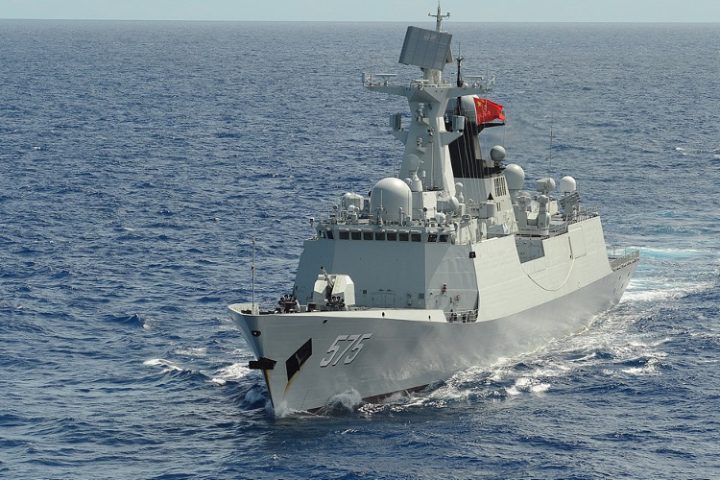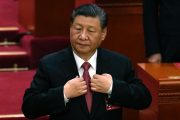
SINGAPORE — On September 24, the Philippines condemned China’s coast guard for erecting a “floating barrier” within its exclusive economic zones, preventing Filipinos from entering and fishing in an area that the Chinese Communist Party (CCP) claims as part of its territory in the South China Sea.
Manila’s coast guard and Bureau of Fisheries and Aquatic Resources “strongly condemn” China’s placement of the barrier in part of the Scarborough Shoal, Commodore Jay Tarriela, a coast guard spokesperson, posted on the X social media platform, formerly known as Twitter.
“The (Philippine Coast Guard) will continue to work closely with all concerned government agencies to address these challenges, uphold our maritime rights, and protect our maritime domains,” Tarriela declared.
In 2012, Beijing unilaterally seized the Scarborough Shoal and coerced fishermen from the Philippines to travel further for smaller catches.
When bilateral ties warmed significantly under then-President Rodrigo Duterte, the Beijing regime permitted Filipino fishermen to return to the uninhabited shoal. Nonetheless, since Duterte’s successor, Ferdinand Marcos, Jr., assumed power last year, bilateral ties have taken a nosedive.
During a routine patrol on September 22 near the shoal, locally known as Bajo de Masinloc, the Philippines coast guard and Fisheries Bureau personnel caught sight of the floating barrier, estimated at 1,000 feet long, installed by the Chinese, Tarriela disclosed.
Three Chinese coast guard rigid-hull inflatable boats and a Chinese maritime militia service boat had erected the barrier when the Philippine vessel arrived, Tarriela added.
Filipino fishermen assert China usually sets up such barriers when they keep track of a large number of fishermen in the area, Tarriela said.
The Chinese boats issued 15 radio challenges and decried the Philippine ship and fishermen for breaching international and Chinese laws, before moving away “upon realizing the presence of media personnel onboard the (Filipino) vessel,” he elaborated.
Nevertheless, Beijing’s maritime allegations have been found to go against international law as reflected in the 1982 UN Convention on the Law of the Sea (UNCLOS), based on the Hague in its 2016 verdict against Beijing’s claims.
The UNCLOS, to which China is a signatory, considers maritime areas within 200 nautical miles of coastal nations’ borders as part of their EEZs.
The Foreign Ministry of the Philippines announced on September 21 that the country was contemplating legal actions against China for its purported destruction of coral reefs within Manila’s exclusive economic zone (EEZ) in the South China Sea.
The ministry added that the Office of the Solicitor General (OSG) would advise it on the matter, pending studies from relevant government agencies regarding the degree of environmental damage in Iroquois Reef, 128 nautical miles (237 kilometers) from the Philippines’ Palawan province.
On September 18, the Philippine Coast Guard (PCG) asserted that Chinese maritime militia ships were culpable for the “severe damage” on coral reefs in Iroquois Reef and Escoda Shoal, both within the Philippines’ EEZ.
The PCG said the continued flooding of Chinese militia ships “for indiscriminate illegal and destructive fishing activities” may have directly led to the degradation and destruction of the marine environment in the areas.
Foreign Ministry spokesperson Ma. Teresita Daza said that UNCLOS obliges states to “protect and preserve the marine environment” in the disputed waters.
“As clarified by the 2016 Arbitral Award on the South China Sea, this obligation applies in all maritime areas, both inside the national jurisdiction of States and beyond it,” Daza said, as per reports from Philippine News Agency.
“States entering the Philippines’ EEZ and maritime zones, therefore, are likewise obliged to protect and preserve our marine environment,” she continued.
Solicitor General Menardo Guevarra said the OSG will evaluate various legal options, including the possible filing of complaints for damages before the Permanent Court of Arbitration (PCA) at The Hague.
In 2013, the Philippines filed its first legal case with the PCA and emerged triumphant in 2016 when the Hague Tribunal ruled that Beijing’s claims in the South China Sea had no legal foundation.
For its part, the Chinese Foreign Ministry dismissed the Philippines’ claims, insisting that Manila should remove its “rusting” BRP Sierra Madre vessel from the Ayungin Shoal if it truly was concerned about the environment.
Besides the Philippines, Taiwan’s Defense Minister Chiu Kuo-cheng slammed China’s “abnormal” military activities around the island on September 22, after Beijing deployed a record-high 103 warplanes toward Taiwan.
In a recent update, Taiwan’s military declared that it had discovered 32 Chinese warplanes and seven vessels near the island on September 21, with 24 planes found crossing the median line of the Taiwan Strait.
“Our enemy’s recent movements are really quite abnormal,” Chiu told reporters at Parliament.
“Our initial analysis is that they are doing joint drills in September, including land, sea, air, and amphibious,” he continued.
Chiu’s remarks came after the Taiwanese Defense Ministry’s statement on September 21 that it was keeping tabs on the CCP’s rocket forces’ operations near Dacheng Bay in Fujian province. Taiwan rarely reveals the location of Chinese military deployments.
Furthermore, the ministry also observed the CCP’s ground forces in the area and declared that it would coordinate the mobilization of mission aircraft, ships, and shore-based missile systems to react when necessary.
The ministry admitted that the number of Chinese warplanes around Taiwan soared to a “recent high” when the CCP dispatched 103 warplanes and nine vessels to Taiwan within a 24-hour period on September 17, with 40 aircraft found entering the median line of the Taiwan Strait.
Notably, the defense ministry said the rise in Chinese warplanes poses “severe challenges” to regional security.
“The Communist Army’s persistent military harassment can easily result in a sharp increase in tensions and worsen regional security,” the ministry said in a statement on September 18.
“We call on the Beijing authorities to take responsibility and immediately stop such destructive unilateral actions,” the statement added.
In turn, China’s Foreign Ministry maintained that “there is no so-called median line in the Taiwan Strait.”
Beijing has never formally acknowledged the unofficial line, which signifies the halfway point between the Chinese and Taiwanese coastlines, although it has mostly acted in line with American pressure not to cross the line, which was set up during the Cold War in relation to the 1954 U.S.-Taiwan Mutual Defense Treaty.
On its end, Taiwan has expressed hopes to deploy at least two new domestically developed submarines by 2027, and possibly install missiles on later models to enhance its deterrence against China’s navy and guard major supply lines, according to the head of Taiwan’s indigenous submarine program.
Taiwan, which China claims as its own territory, has made the aforementioned program a crucial element of an ambitious project to overhaul its armed forces, as Beijing has been conducting almost-daily military drills to assert its territorial claims.
Taiwanese President Tsai Ing-wen, who championed the program after taking office in 2016, is scheduled to launch the first of eight new submarines on September 28 under a plan that has relied on the expertise and technology from several countries, despite the island being officially internationally isolated on the diplomatic front.
Admiral Huang Shu-kuang, Tsai’s security advisor, who is directing the program, said a fleet of 10 submarines, which encompasses two Dutch-made submarines commissioned in the 1980s, would pose challenges to the Chinese navy to assert influence in the Pacific.
“If we can build up this combat capacity, I don’t think we will lose a war,” Huang in September divulged during an internal briefing on the project, according to Reuters reports.
Huang said the first new submarine, with a price tag of NT$49.36 billion, will use a combat system by U.S. arms and defense company Lockheed Martin, and carry U.S.-made MK-48 heavyweight torpedoes. The submarine would undergo sea trials in October before being dispatched to the navy by the end of 2024.
For future models, Taiwan will consider submarine-launched anti-ship missiles, but having those weapons on board hinges on production availability in the United States, where capacity is already tight, Huang said, without elaborating on the names of participating companies.
Also, Huang called the submarines a “strategic deterrent” to Chinese warships crossing the Miyako Strait near south-western Japan, or the Bashi Channel that divides Taiwan and the Philippines. He added that Taiwan’s diesel-electric submarines could deter China within the first island chain, alluding to the area that runs from Japan to Taiwan, the Philippines and on to Borneo, surrounding China’s coastal seas.
“This was also the strategic concept of the US military — to contain them within the first island chain and deny their access,” Huang said. “If Taiwan is taken, Japan [and] South Korea will definitely not be safe.”
The Chinese navy, including its Shandong aircraft carrier, has become increasingly assertive in recent months off Taiwan’s eastern coastline, entrenching fears that China could stage an attack from that direction.
Huang said the submarines could help maintain the island’s “lifeline” to the Pacific by ensuring that ports along Taiwan’s eastern coast remain open to supplies in a conflict.
“The submarines will keep [Chinese] ships away from our eastern shores,” he said.
Chieh Chung, a military researcher at Taiwan’s National Policy Foundation think-tank, said the fleet would experience difficulties with that task, as China could position warships in the Pacific before conducting an attack.
However, Chung continued, stating that the submarines could be placed at strategic ambush points in the region and “greatly harm [China’s] combat ability” by targeting high-value ships such as carrier groups or landing fleets.
A Reuters study has revealed that Taiwan has amassed technology, components, and talent from at least seven nations on a low-key basis to help it build submarines.
Obtaining foreign assistance was especially tough for Taiwan, which does not have official relations with most countries.
Although Huang did not reveal which countries had green-lit export permits, he said he had contacted generals from countries that included the United States, Japan, South Korea, and India.
“The foreign generals who agreed with my ideas … helped convey the message to their governments or arrange meetings,” he said. “I told them our needs and that’s how we achieved our purpose of securing export permits.”
Huang also voiced his gratitude for the “great help” offered by a team led by an unnamed retired rear admiral of the U.K. Royal Navy, who obtained export permits from the U.K. via a Gibraltar-based company.
The U.K. ramped up the amount of submarine parts and technology exports authorized in 2022 for Taiwan, a Reuters analysis of the data depicted.
Huang indicated that China’s frequent military harassment, including its close approaches to Taiwan’s territorial waters and airspace, has made Taiwan and the United States reconsider the island’s “asymmetrical” strategy of making its forces more mobile and harder to attack.
“American thinking is changing gradually. They realized that you can’t withstand [the harassment] without bigger boats,” Huang said, referring to the navy’s plan to construct a new generation of bigger frigates.
“They are getting closer and closer,” he added, alluding to China. “Taiwan can’t drive them out with small boats. We must use bigger boats.”
For years, China has been asserting territorial claims on 90 percent of the South China Sea, which overlaps with the exclusive economic zones (EEZs) of Vietnam, Malaysia, Brunei, Indonesia, and the Philippines.



